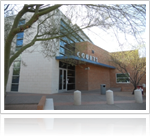
Gilbert DUI – Is DUI Breath Evidence Reliable?
A DUI case requires an attorney with knowledge of the forensic science involved in both breath and blood testing. Each method has its own potential error sources and each method has its own unique vulnerabilities. In this post, we will discuss a breath based DUI and the potential weaknesses inherent in this method of measuring blood alcohol levels in a person's system.
Blood alcohol concentration, as measured by a breath analysis machine, is a complicated process where ethanol particles found in the breath of the person being tested absorbs infrared light produced inside the breath analysis machine. The resulting loss of light is measured to determine the amount of ethanol present in a given sample. In this sense, the machine uses an inverse relationship between the loss of light sharing a direct relationship to the amount of alcohol present in a given breath sample. In other words, the lower the light level present in the machine translates to more alcohol being present in the breath sample being analyzed. This amount is then converted to the level of alcohol thought to be present in the blood of the person being tested.
Breath alcohol machines (Intoxilyzer 5000 and 8000) utilize a constant blood-to-breath partition ratio of 2100 to 1. (See: Fitzgerald, E.F. Intoxication Test Evidence 2nd, §28.1, West Pub.: Eagan, MN 2004) This ratio is called the partition ratio and tracks a law of physics known as Henry's Law. Scientific studies have called into question this 2100:1 ratio as being overly simplistic, and not a reliable indicator of the true blood-to-breath ratio of a given individual. In fact, published studies have shown a wide range of blood-to-breath ratios. Fitzgerald, citing Dubowski, has found that a normal range within the human population can vary from 1100:1 on the low end to as high as 3000:1. (See Fitzgerald, supra, at § 28.1) In other words, if a person's true ratio is less than the 2100:1 ratio, which is pre-programmed into the machine, then the reported result will be higher than the true ethanol concentration found in the individual who is being tested.
In addition, to further complicate matters, much of this evidence is only admissible in an Arizona courtroom under certain conditions, principally to undermine the allegations of impairment presumptions contained in Arizona law. Thus, it is not only important to retain an attorney who understands the complexity of this science, but the attorney should be familiar with the manner in which it may become admissible during a DUI trial. There are other factors that can also undermine the reliability and accuracy of breath analysis machines including the following:
• Radio Frequency Interference (radio frequencies in the air, from cell phones and police radios, effecting the actual functioning of the machine during the test);
• Health conditions;
• Breathing patterns of the person being tested;
• Mouth alcohol (Residual alcohol in the mouth causing artificially inflated results);
• Acetone, acetaldehyde or other volatile compounds on the breath (As seen with people exposed to certain industrial compounds and people with certain health problems like Diabetes.);
• Stress of the person being tested;
• Testing during pre-elimination phase;
• Contaminated equipment;
• Individual core body temperature;
• Lack of linearity being established by the simplistic calibration method employed on a breath machine.
These are just some of the factors that may operate to undermine the validity of breath test results in your case. It is only a general overview of the issues you need to concern yourself with when investigating a breath based DUI case. You should seek out and retain a competent criminal defense attorney to assist you in determining which, if any, of the potential error sources discussed herein may be applicable to your individual case.
Mr. Buckallew is a Board Certified Criminal Law Specialist, having been certified by the Arizona State Bar, Board of Legal Specialization. This means that he has shown significant experience in criminal law, has demonstrated a high degree of professionalism, competence and integrity, and has met all other requirements and qualifications set forth by the AZ Board of Legal Specialization. Mr. Buckallew has handled countless DUI cases in Gilbert, including misdemeanor DUI charges in the Gilbert Municipal Court and the Highland Justice Justice Court, as well as felony DUI cases in the Maricopa County Superior Court. He has a proven track record of successfully resolving many of the DUI cases he has handled over the course of his career – ranging from acquittals after trial, dismissals, and reduction in charges.* Each case is unique and the Firm provides a free consultation to discuss your legal options. If you have been charged with a 1st Time DUI, Extreme DUI, Aggravated DUI, Underage DUI or any other DUI in Gilbert, AZ, contact the Firm to schedule a no obligation meeting with a Board Certified Criminal Defense Attorney.
Copyright © 2011 Trent R. Buckallew, Attorney at Law Excerpt from book entitled Arizona DUI/Criminal Traffic Defense Strategies written by Attorney Trent R. Buckallew The Law Offices of Trent R. Buckallew, PC Arizona Criminal Defense Attorney
*All cases are factually different and prior success on individual cases is not a guarantee of future outcomes. The firm cannot, and does not make any guarantees as to the outcome of your case.
**This blog should be used for informational purposes only. It does not create an attorney-client relationship with any reader and should not be construed as legal advice. If you need legal advice, please contact the Firm to schedule a consultation regarding your case.
 Arizona DUI & Criminal Defense Lawyer Blog
Arizona DUI & Criminal Defense Lawyer Blog



